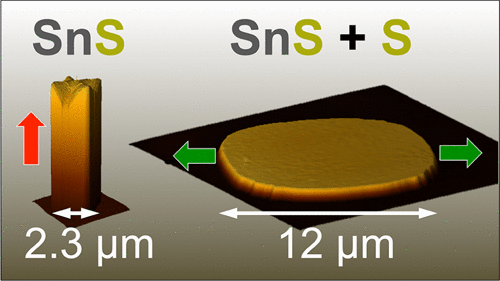当前位置:
X-MOL 学术
›
Chem. Mater.
›
论文详情
Our official English website, www.x-mol.net, welcomes your feedback! (Note: you will need to create a separate account there.)
Surface Passivation by Excess Sulfur for Controlled Synthesis of Large, Thin SnS Flakes
Chemistry of Materials ( IF 8.6 ) Pub Date : 2020-09-11 , DOI: 10.1021/acs.chemmater.0c03297 Eli Sutter 1 , Jia Wang 1 , Peter Sutter 2
Chemistry of Materials ( IF 8.6 ) Pub Date : 2020-09-11 , DOI: 10.1021/acs.chemmater.0c03297 Eli Sutter 1 , Jia Wang 1 , Peter Sutter 2
Affiliation

|
Tin sulfide (SnS) is a part of the group IV chalcogenides (SnX, GeX; X:S, Se), a family of anisotropic layered materials considered for thin-film photovoltaics, optoelectronics, and valleytronics and predicted narrow band gap multiferroic materials. Large ultrathin SnS flakes, suitable for a variety of applications, are challenging to synthesize because of the enhanced surface reactivity due to the open layer structure of SnS, which gives rise to a competition between lateral and vertical growth. Here, we investigate the effects of added sulfur on passivating the surface and modifying the balance between lateral expansion and thickening of SnS flakes in chemical vapor transport from a SnS precursor. We investigate the growth of SnS flakes and compare the results of synthesis from a pure SnS precursor with growth, in which a slight excess of sulfur is supplied in different ways. Our results demonstrate that small amounts of excess sulfur can profoundly affect the size and thickness distributions of SnS flakes. The largest and thinnest flakes are obtained if (i) traces of sulfur are added and (ii) the sulfur source consists of either small Sx fragments released at high temperatures from the reactor walls or atomic S supplied by sublimation from SnS2. The likely mechanism for the observed growth modifications is a transient surface passivation of SnS flakes during growth, which reduces the reactivity of the top facet of the flakes, limits vertical growth, and thus gives rise to ensembles with increased lateral size and reduced thickness.
中文翻译:

通过过量硫进行表面钝化,以控制合成大而薄的SnS薄片
硫化锡(SnS)是IV组硫属元素化物(SnX,GeX; X:S,Se)的一部分,后者是一类各向异性的层状材料,考虑用于薄膜光伏,光电子学和Valleytronics,以及预期的窄带隙多铁性材料。适用于多种应用的大型超薄SnS薄片由于SnS的开放层结构提高了表面反应性,因此难以进行合成,从而引起横向和纵向生长之间的竞争。在这里,我们研究了添加的硫对钝化表面的影响,并改善了从SnS前体化学气相传输SnS薄片的横向膨胀和增稠之间的平衡。我们调查了SnS薄片的生长情况,并将纯SnS前体的合成结果与生长情况进行了比较,其中以不同的方式提供略微过量的硫。我们的结果表明,少量过量的硫会深刻影响SnS薄片的尺寸和厚度分布。如果(i)添加痕量的硫,并且(ii)硫源由较小的S组成,则可获得最大和最薄的薄片X在从通过升华从供给的SnS反应器壁或原子的高的温度下释放的片段2。观察到的生长修饰的可能机制是生长过程中SnS薄片的瞬时表面钝化,这会降低薄片顶部小面的反应性,限制垂直生长,从而导致整体尺寸增加和厚度减小的集合体。
更新日期:2020-09-22
中文翻译:

通过过量硫进行表面钝化,以控制合成大而薄的SnS薄片
硫化锡(SnS)是IV组硫属元素化物(SnX,GeX; X:S,Se)的一部分,后者是一类各向异性的层状材料,考虑用于薄膜光伏,光电子学和Valleytronics,以及预期的窄带隙多铁性材料。适用于多种应用的大型超薄SnS薄片由于SnS的开放层结构提高了表面反应性,因此难以进行合成,从而引起横向和纵向生长之间的竞争。在这里,我们研究了添加的硫对钝化表面的影响,并改善了从SnS前体化学气相传输SnS薄片的横向膨胀和增稠之间的平衡。我们调查了SnS薄片的生长情况,并将纯SnS前体的合成结果与生长情况进行了比较,其中以不同的方式提供略微过量的硫。我们的结果表明,少量过量的硫会深刻影响SnS薄片的尺寸和厚度分布。如果(i)添加痕量的硫,并且(ii)硫源由较小的S组成,则可获得最大和最薄的薄片X在从通过升华从供给的SnS反应器壁或原子的高的温度下释放的片段2。观察到的生长修饰的可能机制是生长过程中SnS薄片的瞬时表面钝化,这会降低薄片顶部小面的反应性,限制垂直生长,从而导致整体尺寸增加和厚度减小的集合体。


























 京公网安备 11010802027423号
京公网安备 11010802027423号